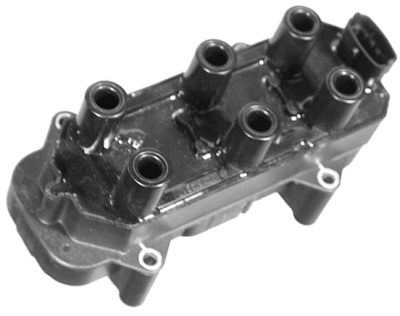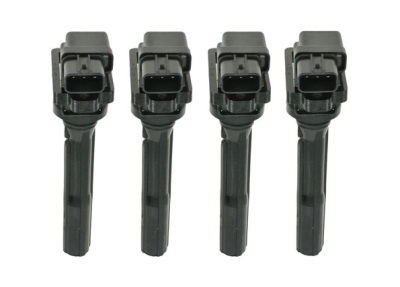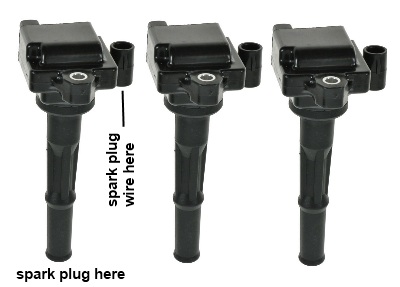Ignition Coils & Ignition Coil Packs
Way back in the early 1900s, ignition coils were becoming more familiar to people because they were a key piece of every automobile engine. The ignition coil would take the low voltage from the battery and amplify it with the magic of magnetic fields. That higher voltage output was then sent out to the spark plugs where it ignited the air-fuel mixture inside the engine. Over one hundred years later, ignition coils look different but still work the same way.
The Distributor-Style Ignition System

This type of simple, two-wire ignition coil was used from the late 1920s until the 1980s. Inside it lives a set of "primary" and "secondary" coil windings that are both wrapped around a piece of iron. When the primary winding is fed power, a magnetic field builds up inside of the coil. If power is then momentarily cut off, the magnetic field inside collapses and it produces a high voltage spike out the secondary winding that is used to fire the spark plugs. With this system, one ignition coil is producing every single spark for every spark plug. That can be quite a workout for the ignition coil at high RPMs!
Three Types of Electric Ignition Systems
By the 1980s, car and truck manufacturers were consistently using electronic ignition. "Electronic ignition" basically meant that a computer told the ignition coil(s) when to fire, based on sensor inputs. This allowed for better engine control, and more importantly, fewer emissions. Around the same time that electronic ignition was splashing into the automotive scene, the world began to see ignition coil packs, coil-on-plug ignition, and the waste-spark ignition system.
What Is An Ignition Coil Pack?

Coil packs are a group of ignition coils that are physically connected together, but provide one ignition coil per cylinder. They are controlled by a computer, which means that distributors, points, and condensers are not needed. The beauty of coil packs is that they provide an extremely large spark to each cylinder whenever the computer asks for it. Their downfall is that if one of the coils within the pack fails, the entire ignition coil pack needs to be replaced. Whole ignition coil packs can potentially be pricey depending on the technology inside them and the vehicle application.
What Is a Coil-On-Plug Ignition Coil?

These days, most car and truck manufacturers have begun to use "Coil On Plug" ignition or "COP" for short. COP ignition has one individual ignition coil per spark plug. This means that spark plug wires are no longer needed, and each cylinder gets a superbly timed and powerful spark. The great thing about this type of ignition system is that they are cheap to fix—if one ignition coil fails, that is the only one that needs to be replaced. The other huge benefit is that, if you are trying to diagnose a misfire issue, you can swap two coils around to see if the misfire moves to the other cylinder. Ignition problem diagnosis becomes a piece of cake!
What Is a Waste-Spark Style Ignition Coil?

Then there is the waste-spark ignition system. Auto manufacturers got clever at some point and realized they could halve the number of parts in the ignition system (compared to the typical coil on plug system), if they fired two spark plugs from one ignition coil. The problem was that the two spark plugs would always have to fire at the same exact time as each other. With some creative placement of spark plug wires, they got one spark to fire at the top of the compression stroke (to make the power stroke happen of course) and the other spark plug fired on an opposite cylinder's exhaust stroke. This effectively "wasted" a spark.
What Causes Ignition Coil Failure?
Usually age or being overworked causes an ignition coil to fail. If the spark plug wires have too much resistance in them or the spark plugs are extremely worn out, it will cause the ignition system to work harder. When that happens, the lifespan of the ignition coil usually shortens. It's also possible for the plastic cases of the coils to crack from being exposed to heat, or corrosion could eat away at the electrical terminals! As with most things in life, if you take care of your ignition system, it will take care of you!
What Are Symptoms of Ignition Coil Failure?
Symptoms of failed ignition coils somewhat depend on the vehicle's system. If a vehicle has a single coil or a coil pack feeding the entire engine, then the engine will likely not run at all when an ignition coil fails. This typically happens abruptly. One day the car will run great, the next day it is dead in the driveway from lack of spark.
For vehicles with a coil-on-plug ignition system, a bad ignition coil would cause a misfire in one or more cylinders at once. The engine will still run, albeit quite powerless, and rough. Some coil-on-plug ignition coils actually control two cylinders with a waste spark system (as described above). In that type of system, some bizarre failures can take place. A single waste-spark coil may cause just one cylinder to misfire, and other times it may cause both cylinders that it controls to misfire.
When it comes down to diagnosis of a weak or failed ignition coil, the "Check Engine Light" is the best place to start. With a scan tool, the trouble code will tell you which cylinders are misfiring. From there, you can either mist some water over the coils or swap the ignition coils from one cylinder to the next to see if the misfire moves positions on the engine. Both are very simple ways of diagnosing a potentially damaged engine ignition coil.
In the video above, we see a 2001 Toyota Tundra 3.4L with a waste-spark style ignition coil on plug system (one coil controls two spark plugs). An ignition misfire was causing this V6 engine to run extremely harsh and feel sluggish. It was caused by two of the original coils sending spark through their cracked plastic casings (seen as an orange spark in the video), instead of through the spark plugs themselves. Adding moisture to the ignition system exacerbates the problem, which is a favorite method of diagnosing this style of ignition coil. Let's face it, sparks are fun to watch. You just don't want to touch them, as they can be over 100,000 volts.
Need Replacement Ignition Coils?

If you need to replace your ignition coil(s), 1A Auto has you covered. We're here to help you get the right part for your vehicle. You can browse our large selection of ignition coils and shop right here or, if you have any questions about the product, warranty, compatibility, or need help, we also have customer service team available.
